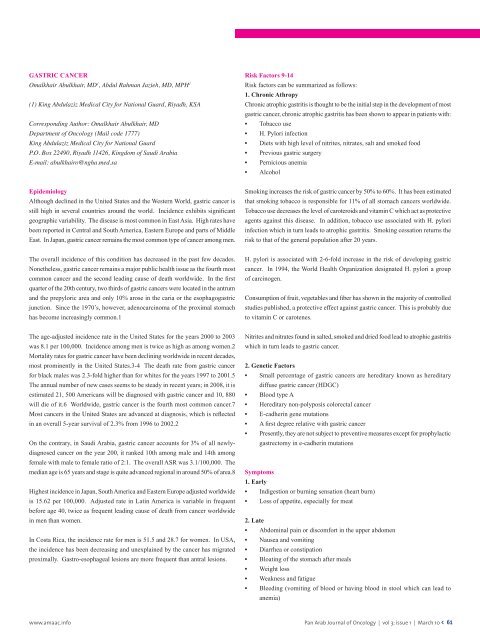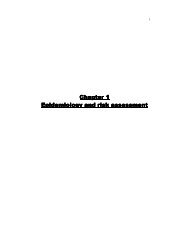Pan Arab Journal of Oncology - Arab Medical Association Against ...
Pan Arab Journal of Oncology - Arab Medical Association Against ...
Pan Arab Journal of Oncology - Arab Medical Association Against ...
You also want an ePaper? Increase the reach of your titles
YUMPU automatically turns print PDFs into web optimized ePapers that Google loves.
GASTRIC CANCER<br />
Omalkhair Abulkhair, MD 1 , Abdul Rahman Jazieh, MD, MPH 1<br />
(1) King Abdulaziz <strong>Medical</strong> City for National Guard, Riyadh, KSA<br />
Corresponding Author: Omalkhair Abulkhair, MD<br />
Department <strong>of</strong> <strong>Oncology</strong> (Mail code 1777)<br />
King Abdulaziz <strong>Medical</strong> City for National Guard<br />
P.O. Box 22490, Riyadh 11426, Kingdom <strong>of</strong> Saudi <strong>Arab</strong>ia<br />
E-mail: abulkhairo@ngha.med.sa<br />
Epidemiology<br />
Although declined in the United States and the Western World, gastric cancer is<br />
still high in several countries around the world. Incidence exhibits significant<br />
geographic variability. The disease is most common in East Asia. High rates have<br />
been reported in Central and South America, Eastern Europe and parts <strong>of</strong> Middle<br />
East. In Japan, gastric cancer remains the most common type <strong>of</strong> cancer among men.<br />
The overall incidence <strong>of</strong> this condition has decreased in the past few decades.<br />
Nonetheless, gastric cancer remains a major public health issue as the fourth most<br />
common cancer and the second leading cause <strong>of</strong> death worldwide. In the first<br />
quarter <strong>of</strong> the 20th century, two thirds <strong>of</strong> gastric cancers were located in the antrum<br />
and the prepyloric area and only 10% arose in the caria or the esophagogastric<br />
junction. Since the 1970’s, however, adenocarcinoma <strong>of</strong> the proximal stomach<br />
has become increasingly common.1<br />
The age-adjusted incidence rate in the United States for the years 2000 to 2003<br />
was 8.1 per 100,000. Incidence among men is twice as high as among women.2<br />
Mortality rates for gastric cancer have been declining worldwide in recent decades,<br />
most prominently in the United States.3-4 The death rate from gastric cancer<br />
for black males was 2.3-fold higher than for whites for the years 1997 to 2001.5<br />
The annual number <strong>of</strong> new cases seems to be steady in recent years; in 2008, it is<br />
estimated 21, 500 Americans will be diagnosed with gastric cancer and 10, 880<br />
will die <strong>of</strong> it.6 Worldwide, gastric cancer is the fourth most common cancer.7<br />
Most cancers in the United States are advanced at diagnosis, which is reflected<br />
in an overall 5-year survival <strong>of</strong> 2.3% from 1996 to 2002.2<br />
On the contrary, in Saudi <strong>Arab</strong>ia, gastric cancer accounts for 3% <strong>of</strong> all newlydiagnosed<br />
cancer on the year 200, it ranked 10th among male and 14th among<br />
female with male to female ratio <strong>of</strong> 2:1. The overall ASR was 3.1/100,000. The<br />
median age is 65 years and stage is quite advanced regional in around 50% <strong>of</strong> area.8<br />
Highest incidence in Japan, South America and Eastern Europe adjusted worldwide<br />
is 15.62 per 100,000. Adjusted rate in Latin America is variable in frequent<br />
before age 40, twice as frequent leading cause <strong>of</strong> death from cancer worldwide<br />
in men than women.<br />
In Costa Rica, the incidence rate for men is 51.5 and 28.7 for women. In USA,<br />
the incidence has been decreasing and unexplained by the cancer has migrated<br />
proximally. Gastro-esophageal lesions are more frequent than antral lesions.<br />
Risk Factors 9-14<br />
Risk factors can be summarized as follows:<br />
1. Chronic Athropy<br />
Chronic atrophic gastritis is thought to be the initial step in the development <strong>of</strong> most<br />
gastric cancer, chronic atrophic gastritis has been shown to appear in patients with:<br />
• Tobacco use<br />
• H. Pylori infection<br />
• Diets with high level <strong>of</strong> nitrites, nitrates, salt and smoked food<br />
• Previous gastric surgery<br />
• Pernicious anemia<br />
• Alcohol<br />
Smoking increases the risk <strong>of</strong> gastric cancer by 50% to 60%. It has been estimated<br />
that smoking tobacco is responsible for 11% <strong>of</strong> all stomach cancers worldwide.<br />
Tobacco use decreases the level <strong>of</strong> caroteroids and vitamin C which act as protective<br />
agents against this disease. In addition, tobacco use associated with H. pylori<br />
infection which in turn leads to atrophic gastritis. Smoking cessation returns the<br />
risk to that <strong>of</strong> the general population after 20 years.<br />
H. pylori is associated with 2-6-fold increase in the risk <strong>of</strong> developing gastric<br />
cancer. In 1994, the World Health Organization designated H. pylori a group<br />
<strong>of</strong> carcinogen.<br />
Consumption <strong>of</strong> fruit, vegetables and fiber has shown in the majority <strong>of</strong> controlled<br />
studies published, a protective effect against gastric cancer. This is probably due<br />
to vitamin C or carotenes.<br />
Nitrites and nitrates found in salted, smoked and dried food lead to atrophic gastritis<br />
which in turn leads to gastric cancer.<br />
2. Genetic Factors<br />
• Small percentage <strong>of</strong> gastric cancers are hereditary known as hereditary<br />
diffuse gastric cancer (HDGC)<br />
• Blood type A<br />
• Hereditary non-polyposis colorectal cancer<br />
• E-cadherin gene mutations<br />
• A first degree relative with gastric cancer<br />
• Presently, they are not subject to preventive measures except for prophylactic<br />
gastrectomy in e-cadherin mutations<br />
Symptoms<br />
1. Early<br />
• Indigestion or burning sensation (heart burn)<br />
• Loss <strong>of</strong> appetite, especially for meat<br />
2. Late<br />
• Abdominal pain or discomfort in the upper abdomen<br />
• Nausea and vomiting<br />
• Diarrhea or constipation<br />
• Bloating <strong>of</strong> the stomach after meals<br />
• Weight loss<br />
• Weakness and fatigue<br />
• Bleeding (vomiting <strong>of</strong> blood or having blood in stool which can lead to<br />
anemia)<br />
www.amaac.info <strong>Pan</strong> <strong>Arab</strong> <strong>Journal</strong> <strong>of</strong> <strong>Oncology</strong> | vol 3; issue 1 | March 10 < 61









